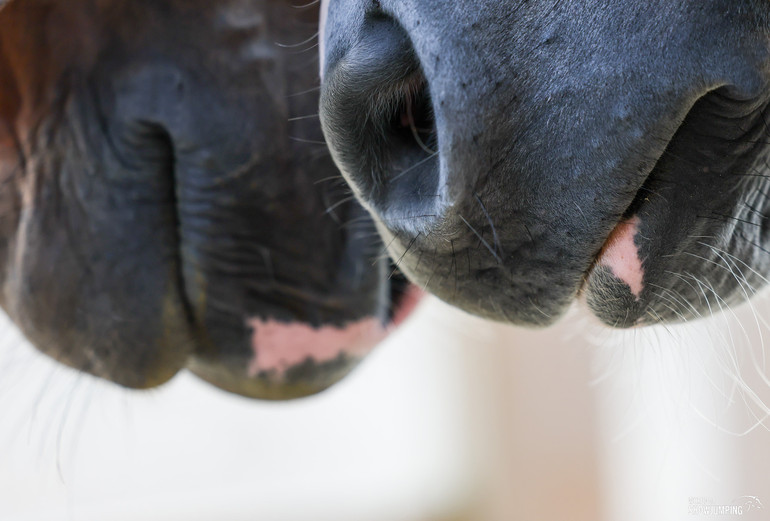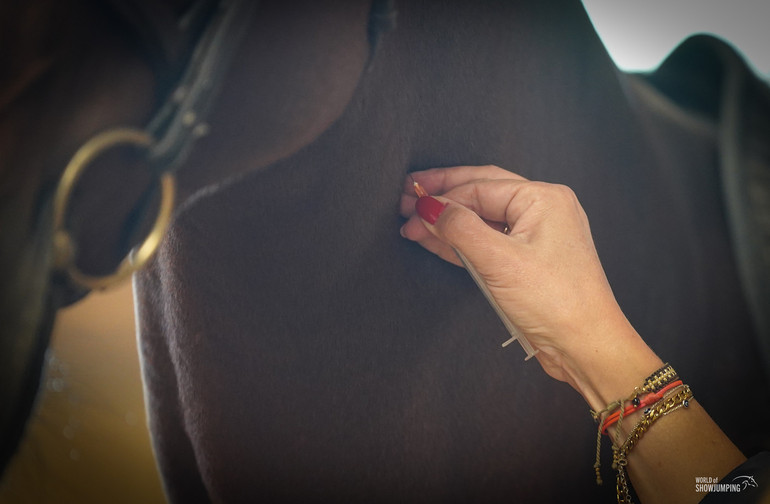Text © World of Showjumping
World of Showjumping called up FEI Senior Veterinary Advisor Caterina Termine to speak about the FEI Equine Anti-Doping and Controlled Medication Regulations (EADCM), the Equine Prohibited Substances List (EPSL), as well as the FEI Veterinary Regulations, and to learn more about the responsibilities of riders and their support teams as well as the most common positive cases and how they are handled.
Mostly controlled medication
The EPSL lists substances that are prohibited, and those substances are divided in two groups: Controlled medication – as in substances that are prohibited in competition – and banned substances – as in substances that are prohibited at all times. “First of all, when we look at the positive test results that we get in jumping horses, we see more substances listed as controlled medication than those listed as banned substances,” Termine begins. “When we look at the controlled medication findings, we are seeing a lot of the same drug classes: We get higher numbers of non-steroidal anti-inflammatory drugs, such as phenylbutazone or flunixin.”
“The next most commonly seen class of drugs are corticosteroids, such as dexamethasone,” she continues. “Those are the top findings when it comes to controlled medication. When it comes to banned substances, we see a slightly different pattern because we see a greater number of different substance classes but we only have very few of each. However, out of all the substance classes that we see, anabolic steroids are seen more frequently than any other type. The most commonly seen banned substances are those classed as anabolic steroids, such as stanozol. It is important to note however that we do not see many of these cases annually.”
“There have been more positive cases with altrenogest last year than the previous three years,” Termine points out about a substance marketed under the name Regu-Mate. “It's prohibited to use altrenogest in male horses, but in female horses, it's allowed. It's difficult for us to know if these positives are contamination cases, because many of these cases have been handled as fast tracks – which means that there's no investigation opened and therefore we don't always get to understand how the substance entered the horse’s body.”
Steady numbers
From the jumping horses tested in 2023, 1.3% tested positive, while in 2022, the same number was 1.2% and in 2021, 0.9%. “The number of tested horses does vary; major championship and multidisciplinary events are some factors that can affect the total numbers, but approximately 2000 jumping horses are tested annually,” Termine explains.
“There are many different reasons as to why we would see a positive result,” she continues. “It could be a case of the person responsible not observing the detection time of a substance and not considering the withdrawal time in addition. You have to add extra time on top of the detection time, and the extra time needed is dependent on multiple factors. For example, the fitness and metabolism of the horse can play a role; if the horse recently has been sick, it might affect how quickly a substance is excreted. There are many factors to take into consideration when deciding how long to wait after the last administration of a substance. If an athlete has any doubts about this, it is important to keep in mind that elective testing can be done on controlled medication. There is a mechanism that's available to athletes to help them if they are having any difficulty and struggle to decide on a safe timeframe.”
While biosecurity is all about infection control, its purpose of controlling contamination links it to anti-doping issues as well. “Good biosecurity can also help in reducing inadvertent positive cases,” Termine points out. “A positive EADCM test result can really tarnish an athlete’s reputation and it's a pity that these accidental contaminations happen when there's something that could be done to avoid them. FEI launched the “Outside the box”-campaign this year, with the purpose of raising people's awareness of things that they can do on a much wider scale to try and prevent contamination and keep their horses healthy and safe.”
Fast track
A EADCM rule violation, such as use of a prohibited substance, evading sample collection, tampering or possession of a banned substance, leads to an investigation and a possible provisional suspension and ends with a decision given by the FEI Tribunal. However, if a EADCM test comes back positive, a case can also be treated as a fast track, when certain criteria are met.
“This is detailed in article 8.3.3. of the EADCM Regulations,” Termine explains. “To sum it up, first of all there has to be no more than one controlled medication finding inside the sample. If you've got one controlled medication with another substance, it doesn't qualify; if you've got two controlled medication or more, it doesn't qualify – it has to be only one within the sample. The next criteria is that the person responsible has to be a first time offender; there can’t be any pending cases or any cases that have been concluded in the past four years. Fast track is not applicable to horses that are taking part in the Olympic Games, the Paralympic Games or the World Equestrian Games. Those are the three things that decide whether a case – a controlled medication finding – is treated as a fast track or not. Treating a case as a fast track means, to put it very simply, that an investigation is not opened and the person responsible is fined."
When it comes to medication, the FEI Veterinary Regulations must be respected as well. “As an example, the sanction for unauthorised possession of syringes, needles or similar equipment within the event site is a fine of 1000 CHF and a disqualification from the event,” Termine points out. “Additionally, if the horse has been injected, it must be submitted to EADCM testing.”
Testing and delegating responsibility
The EADCM testing is carried out by independent testing personnel appointed by the FEI. While the rider is the person responsible, in reality it is often the groom that accompanies the horse to testing.
“The person responsible can delegate the responsibility to the groom or another member of their support team,” Termine explains. “When you're notified of testing, you have to go, because evading testing, refusing to go or failing to submit the sample is considered an EADCM rule violation. Horses can be tested at any time during the event and also multiple times at the same event, so even if you're asked more than once to go to testing, you still have to go,” she points out.
“The person responsible or their designee should make sure that they pay attention to all parts of the sampling. The testing veterinarian will identify the horse, collect samples and pack the samples back into the sampling kit. At the end of the procedure, the person responsible or their designee will have to sign the sampling form, which is something that they have to be prepared to do and therefore they must observe the whole process carefully. When signing the form, they either accept the validity of the procedure or dispute it, but in case of a dispute, they have to be able to identify the reason – therefore paying attention and observing the whole procedure is essential.”
Independent testing personnel
“Most of the time, the method of selecting horses for testing is a random number generator,” Termine continues. “However, the method of selecting the horses for testing is agreed upon by the veterinary delegates and the ground jury. For the Olympic Games, the Paralympic Games, and the World Championships it's obligatory to test the top three horses. Targeted testing can be done as well, for example in case of a serious injury or a fatality. Also, if somebody believes that there's foul play, a horse can be selected for targeted testing. However, there must be a very specific reason for this.”
“There shouldn't be any interference with the testing by anybody,” Termine points out. “The people doing the testing are independent and appointed by the FEI, not by the organisers. Tampering or attempted tampering with any part of doping control by a person responsible, member of the support personnel or any other person is an EADCM rule violation. In the testing situation, it's important to observe, but it’s also important to remember that one shouldn’t interfere with any of the testing equipment because it could be considered as tampering. The testing box should be somewhere quiet and out of the way because we want the horses to relax and everybody to be comfortable with the process. A testing box not being suitable is something we would follow up on, if it was reported to us.”
Reach out
“With the new Key Event Requirements (KER), we have a process in place,” Termine says when asked how the FEI keeps up with what is happening at the varying FEI events around the globe. “In fact, we can now appoint foreign veterinary delegates to any event where we feel support is needed, there is that potential in the new rules. We're trying to support our vets the best we can, to make everything as good as possible, because that's what we all want for the horse. We have to always keep the horse in mind first and foremost, and we have to understand that our sport is under scrutiny. We have to make sure that we are doing the very best for our horses and that people see that. And, we have to do our best, even when we're not in the spotlight.”
“We also have to think about the code of conduct for the welfare of the horse and that's applicable at all times, not just in competition,” Termine concludes. “If you are uncomfortable about something or you feel that there is something we at the FEI Veterinary Department should be aware of, just drop an e-mail to us, and we can look into it. Would you have any concerns at any event, the veterinary delegate is the person to approach first as they are responsible for solving any issues arising on site and they have the duty to report back to the FEI. An online reporting mechanism for grooms was created last summer as well, where they can share their concerns directly to the FEI via a feature in the HorseApp.”
The FEI Veterinary Department can be contacted on [email protected].
25.3.2024 No reproduction of any of the content in this article will be accepted without a written permission, all rights reserved © World of Showjumping.com. If copyright violations occur, a penalty fee will apply.
















